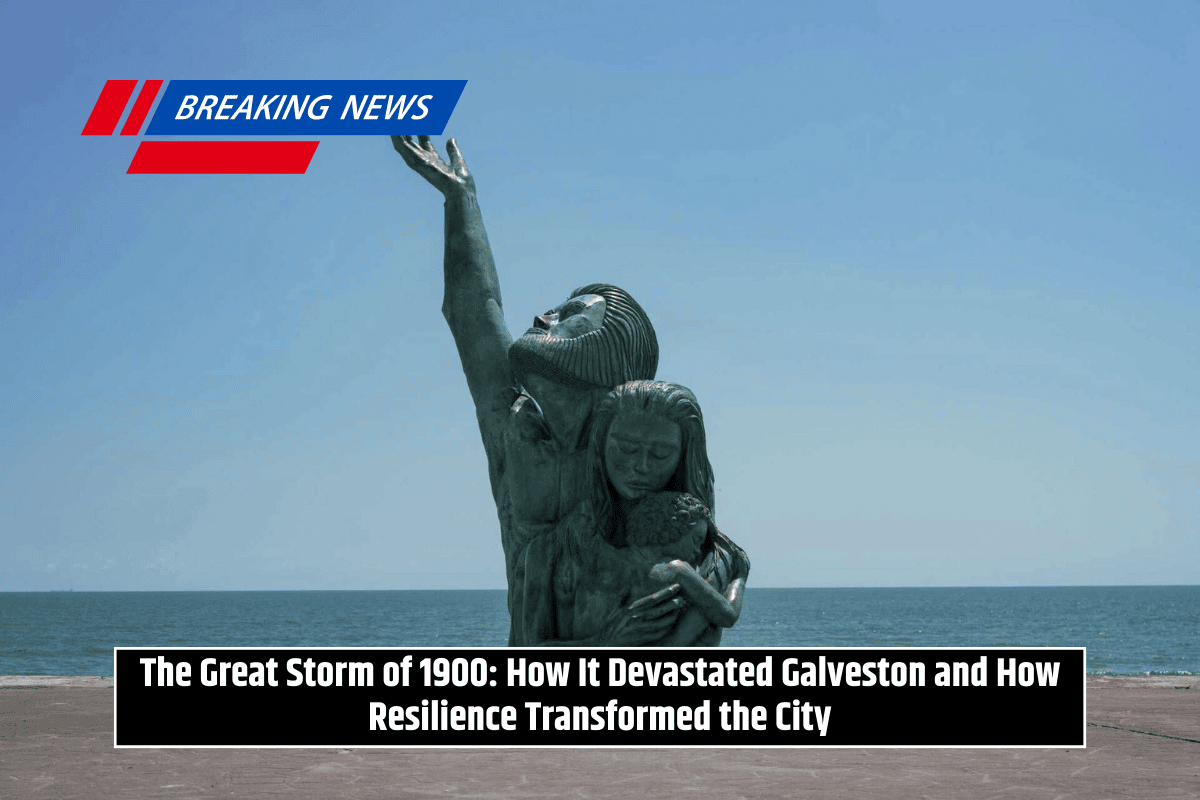Before the Great Storm of 1900, Galveston was thriving as one of the busiest ports in North America. With electric streetlights, grand hotels, and Victorian mansions, it rivaled New Orleans as the Gulf Coast’s crown jewel. But on the night of September 8, everything changed.
A massive storm surge, nearly 15 feet high, overwhelmed the island, submerging entire neighborhoods in raging Gulf waters. Winds exceeding 100 mph tore through the city, leaving devastation in their wake. By morning, Galveston was a city in ruins, with estimates placing the death toll at up to 8,000.
A City’s Will to Rebuild
In the aftermath of the deadliest natural disaster in U.S. history, many considered abandoning Galveston. Neighbors recovered bodies in the oppressive heat, and entire communities were swallowed by the storm.
But for some survivors, the devastation didn’t mark the end. Instead, it ignited a fierce determination to rebuild. They began salvaging materials from the wreckage, clearing the debris, and reopening businesses.
Eventually, storm-ravaged churches rang their bells again. Galveston’s recovery would be more than rebuilding—it would be about reimagining survival itself.
Engineering a Future of Resilience
In 1902, the city embarked on a monumental engineering project: the construction of a seawall to protect against future storm surges. Rising over 17 feet and stretching for miles, the seawall would stand as both a barrier and a symbol of the island’s unyielding spirit.
At the same time, workers embarked on another ambitious task—raising the entire city. Using thousands of jacks, entire neighborhoods were lifted, and dredges filled the land beneath with sand, elevating Galveston above the floodplain.
Enduring Landmarks and Timeless Craftsmanship
Despite the destructive power of the 1900 storm, some of Galveston’s most iconic landmarks, such as the Bishop’s Palace and Ashton Villa, endured with little damage. Their thick stone walls withstood the winds, serving as a testament to the craftsmanship, foresight, and resilience of their builders.
The seawall, the elevated city, and the enduring homes all tell a unified story: resilience is not born of luck but crafted through design and determination.
Testing the Seawall: A History of Survival
Though the battle with the Gulf has never ceased, Galveston’s infrastructure stood firm in the face of subsequent storms. Hurricane Carla in 1961 tested the seawall, followed by Hurricane Alicia’s flooding in 1983. In 2008, Hurricane Ike struck, submerging 75% of the island.
Yet, despite the fury of each storm, the seawall held, the raised homes stayed above floodwaters, and Galveston rose again. The city’s history continues to shape daily life, with homes on stilts and neighborhoods designed to withstand the worst.
Cultural Resilience in Galveston
Today, resilience is deeply ingrained in the island’s culture. Every hurricane season, preparation feels as natural as breathing. The story of the Great Storm of 1900 is woven into the fabric of the city’s identity, taught to children as part of their heritage.
Galveston’s continued endurance is a reminder that while storms will always come, the city will continue to stand.
Facing the Future: Galveston’s Climate Change Challenge
As climate change intensifies the frequency and severity of storms, Galveston’s history offers both a warning and a lesson. No community is invincible, but bold, proactive measures work. Galveston’s past teaches that audacity in the face of disaster can redefine the future.
Today, the city’s path forward requires climate-conscious planning, resilient infrastructure, and policies that prioritize preparation over reaction. Galveston’s legacy shows that with resilience and adaptation, future generations can shape their destiny, just as the city did 125 years ago.
A Timeless Truth
The Great Storm of 1900 left an indelible mark on Galveston, teaching a timeless truth: storms will always humble humanity. But through resilience, determination, and bold adaptation, communities can rebuild and endure.
Galveston’s ability to rise from the waters is a testament to the enduring strength of its people—and a promise that the city will continue to stand, no matter what the future holds.
